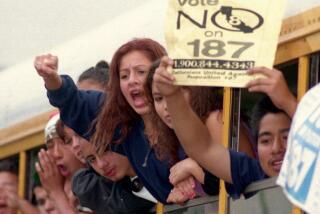Changing of the Political Guard : Experts expect blacks to lose power as they move out of South-Central and Latinos and Asians replace them. : NEXT L.A. / A look at issues, people and ideas helping to shape the emerging metropolis
- Share via
It is not a question of if it will happen. The only question now is when will Los Angeles’ shrinking African American population result in fewer black elected officials?
“A lot of us have been handicapping this one for a long time,” said veteran political consultant Chris Hammond. “The assumption is that somewhere down the road--I don’t know if it will be the year 2000--we’re going to lose a council seat.”
Such certainty, especially among black political operatives, results from the steadily increasing number of Latino and Asian residents moving into traditional black enclaves of South Los Angeles.
The newcomers are not yet flexing their democratic muscle, but the assumption is that the number of Latino and Asian American elected officials is bound to rise. Eventually, said Rod Wright, an aide to Rep. Maxine Waters (D-Los Angeles), “that increase will have to come out of the African American community’s [representation].”
Or will it? Los Angeles voters have long shown a willingness to cross ethnic lines. Former City Councilman Arthur K. Snyder, a redhead of Irish descent, was repeatedly reelected in an overwhelmingly Latino Eastside district. No black candidate ever mounted a serious challenge to former County Supervisor Kenneth Hahn in a predominantly black South Los Angeles district.
*
And while former City Councilman Michael Woo had an Asian base in Chinatown, Asian Americans were far from the majority in his old Hollywood district.
The king of multiethnic politics, of course, was Tom Bradley, the black police lieutenant who put together enough coalitions of the Jewish community, white liberals and Latinos to be elected mayor in 1973 in a city with an African American population of about 11%. He went on to serve five terms.
“Multicultural political coalitions are the only way African American politicians can get elected in the future,” Hammond said.
Those coalitions offer the best chance for Los Angeles’ black community to hold on to power longer, said Cal State Fullerton political scientist Raphael J. Sonenshein, now a visiting scholar at USC’s Center for Multiethnic and Transnational Studies.
The critical question, he said, is what kind of leader will eventually have the trust to be able to speak to blacks and Latinos. A hopeful model is the Community Coalition Against Substance Abuse, which has drawn together blacks, Latinos and Asian Americans in a campaign to stem the proliferation of liquor stores in South-Central Los Angeles.
The real test for blacks will be trying to develop ways to “hold a share of the power without the numbers,” Sonenshein said. “Political power is different than officeholding,” he said. While blacks may lose some offices, he said, they “are going to continue to be a very important part of the political process.”
Kerman Maddox, a black political analyst who ran unsuccessfully for the Los Angeles City Council, said the clout of African Americans should continue because of new leaders who have emerged outside politics.
“Many significant players are not elected,” he said. “Magic Johnson--with his theaters and $5-million contribution to Bishop Charles Blake’s church--has done more to spur economic growth in the black community than elected officials have been able to achieve for years.”
Still, City Councilwoman Rita Walters, who is black, said she knows that the electorate in her 9th District eventually will become Latino.
“As they become citizens, I expect they will vote and will want to see representation by Latinos,” she said. “I certainly understand it’s a natural tendency, particularly among underrepresented people, of wanting to see members of their ethnic group representing them.”
While Latinos made up more than 60% of the population in Walters’ district when she was elected four years ago, they were only about 10% of the eligible voters. In the wake of Proposition 187, Latino community organizations have undertaken unprecedented drives to persuade legal residents to become citizens who can then register to vote.
*
The last census revealed the trend feeding the rethinking of ethnic politics in South Los Angeles. After decades of growth, the city’s black population dipped 3% from its 1980 level. The 1990 census found 487,674 blacks in Los Angeles, about 14% of the city’s 3.5 million residents.
But the African American population skyrocketed in the suburbs in the ‘80s. In Palmdale the black population shot up 947%, Burbank went up 275% and Walnut rose 287%.
Further to the east, San Bernardino and Riverside counties picked up nearly 30,000 black residents from Los Angeles County during the 1980s.
“When I visit a friend in Moreno Valley, I feel as though I’m in South Los Angeles,” said Maddox. “The difference is that kids can play in the streets and yards. They don’t have to worry about drive-bys.”
As the suburban black population ballooned, the share of African Americans in South-Central Los Angeles dropped 18%--while the percentage of Latinos more than doubled. “Blacks have recently been moving to areas quite distant from the traditional black ghetto,” said sociologist Melvin Oliver, director of UCLA’s Center for the Study of Urban Poverty.
Blacks have been overrepresented in Los Angeles, Oliver said, adding, “I think we are seeing the last gasp of moral and political authority for blacks in the sociopolitical arena.”
The moral authority that flowed from the civil rights movement and the Bradley campaign has largely been lost in the wake of the O.J. Simpson verdicts, he said, adding that the wounds opened by the verdicts could prove to be major stumbling blocks to political coalitions.
Sonenshein, however, is more optimistic, comparing reactions to the verdicts to aftershocks from an earthquake, weakening as time goes on.
Whether the color of Los Angeles politics begins to change significantly in four years or 12, which many analysts see as more realistic, there is little disagreement that the year 2000 will precipitate a major reapportionment battle that could realign power at the expense of blacks.
*
Hammond said he “can’t help but wonder” how several legislative and congressional districts “will break out in in the year 2000, particularly if Democrats don’t control the State Assembly.”
“There will be a huge battle after the next census,” he said. “If I were [a Republican] trying to consolidate my hold on the state or on Congress, I would try to take out my opponents. And that’s certainly the African American population.”
(BEGIN TEXT OF INFOBOX / INFOGRAPHIC)
Blacks on the Move
The African American population of Los Angeles County became less concentrated between 1980 and 1990 as families moved from traditional enclaves into newer suburbs. Surrounding counties also saw a marked increase in the percentage of balck as African Americans moved from Los Angeles.
*
Moved in:
Burbank: +275%
Palmdale: +947%
Glendora: +175%
Alhambra: +144%
El Monte: +107%
Walnut: +287%
Diamond Bar: +111%
Rowland Heights: +166%
Norwalk: +151%
Paramount: +306%
Bellflower: +328%
Torrance: +118%
*
Moved out:
Lennox: -43%
Willowbrook: -17%
Lynwood: -13%
W. Compton: -16%
Compton: -18%
Carson: -8%
*
Migrating Out:
Percentage of blacks living in each county.
1970
Orange: 0.9%
Riverside: 2.7%
San Bernardino: 3.8%
Ventura: 0.6%
Los Angeles: 92.0%
*
1990
Orange: 3.3%
Riverside: 5.0%
San Bernardino: 9.6%
Ventura: 1.2%
Los Angeles: 80.9%
*
Migration of Los Angeles County blacks, 1985- 90
*--*
Into L.A. Out of L.A. Net From/ to northern U.S. 19,682 11,932 7,750 From/ to southern U.S. 26,897 24,991 1,906 From/ to western U.S. 4,043 11,757 -7,714 From/ to San Bernardino/ 3,367 32,474 -29,107 Riverside counties From/ to rest of California 12,142 21,190 -9,048
*--*
Source: U.S. Bureau of the Census
Compiled by RICHARD O’ REILLY, Times director of computer analysis
More to Read
Sign up for Essential California
The most important California stories and recommendations in your inbox every morning.
You may occasionally receive promotional content from the Los Angeles Times.










